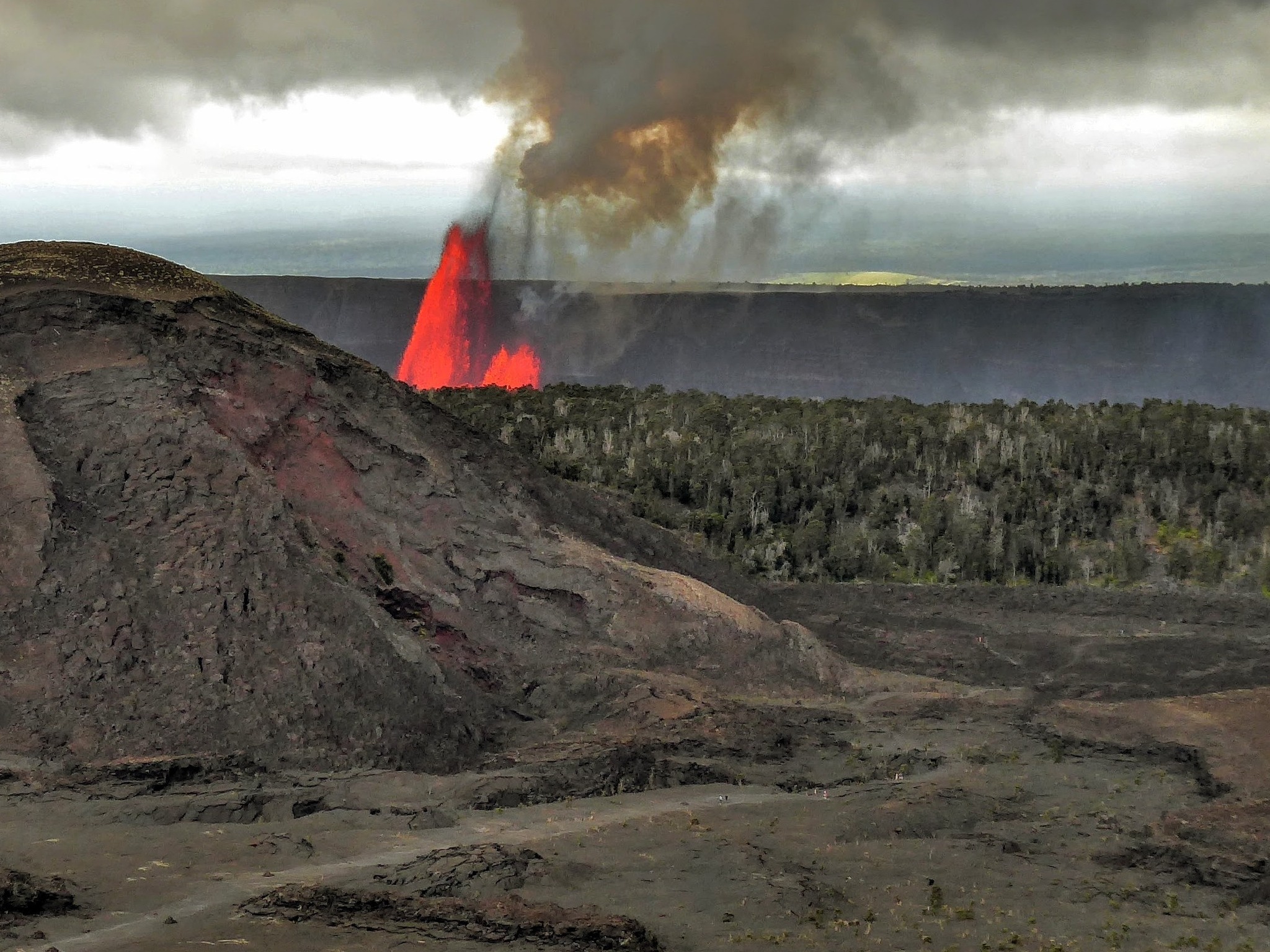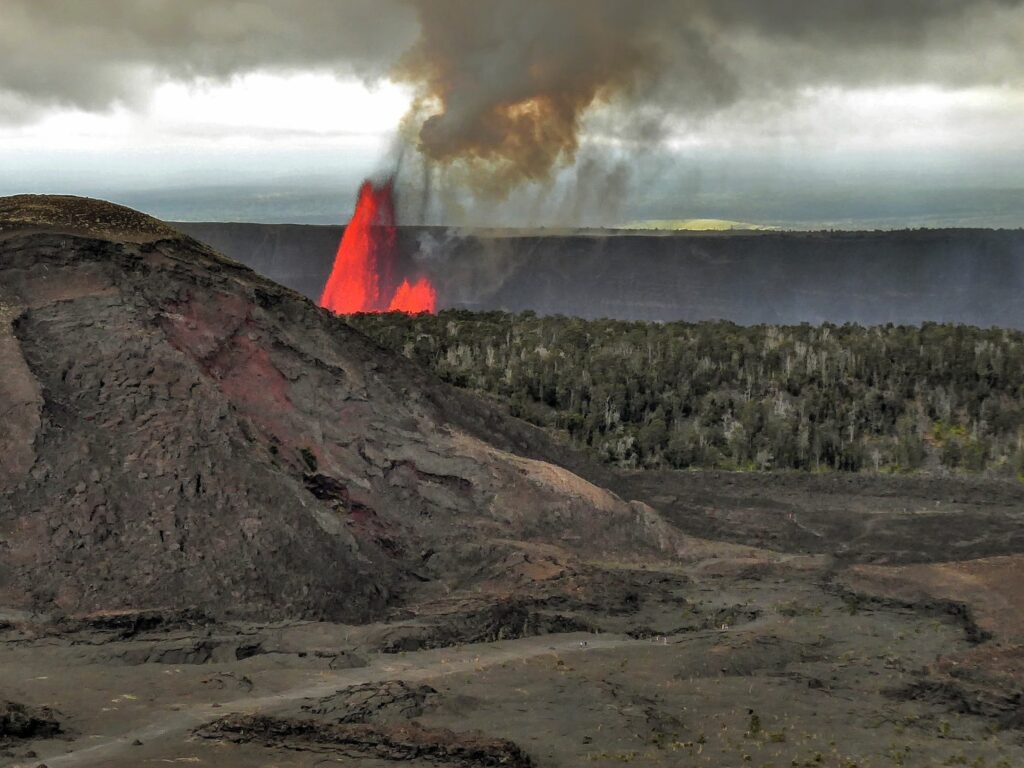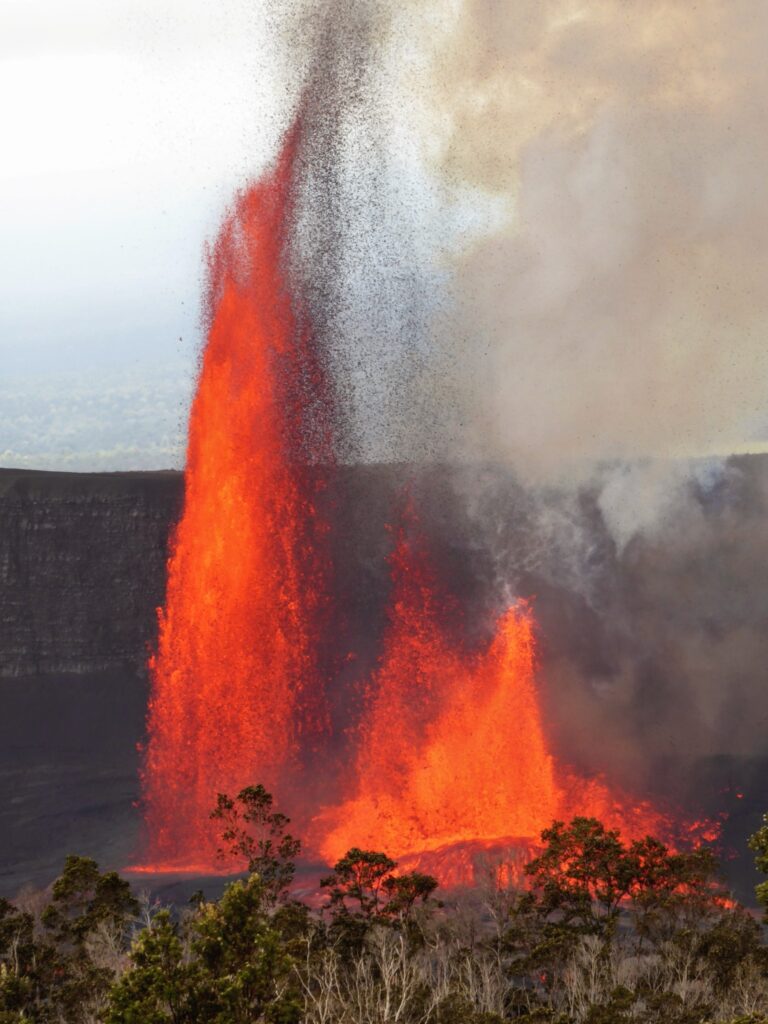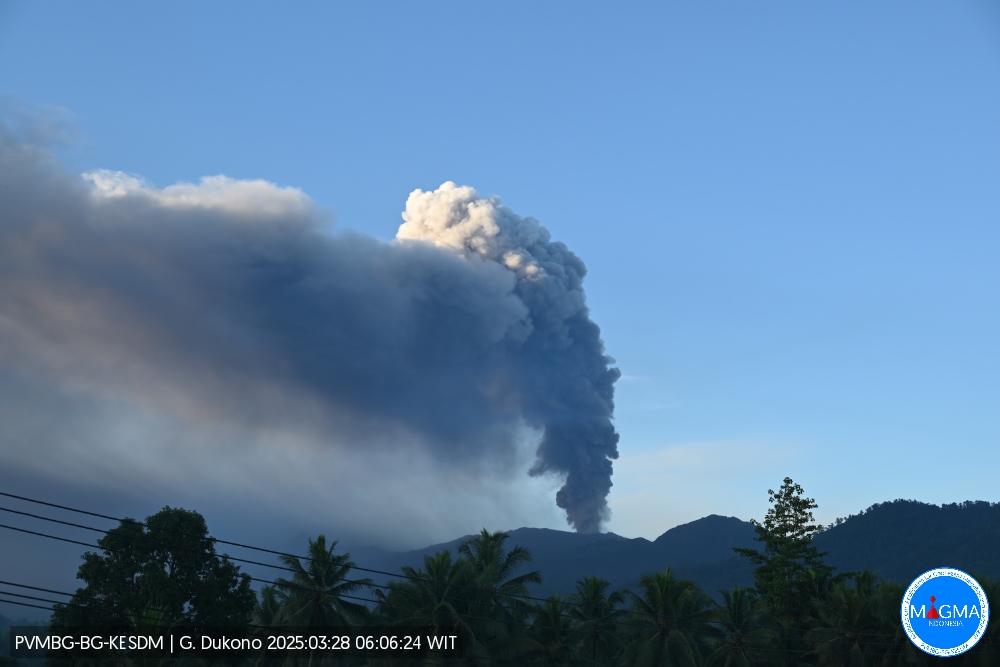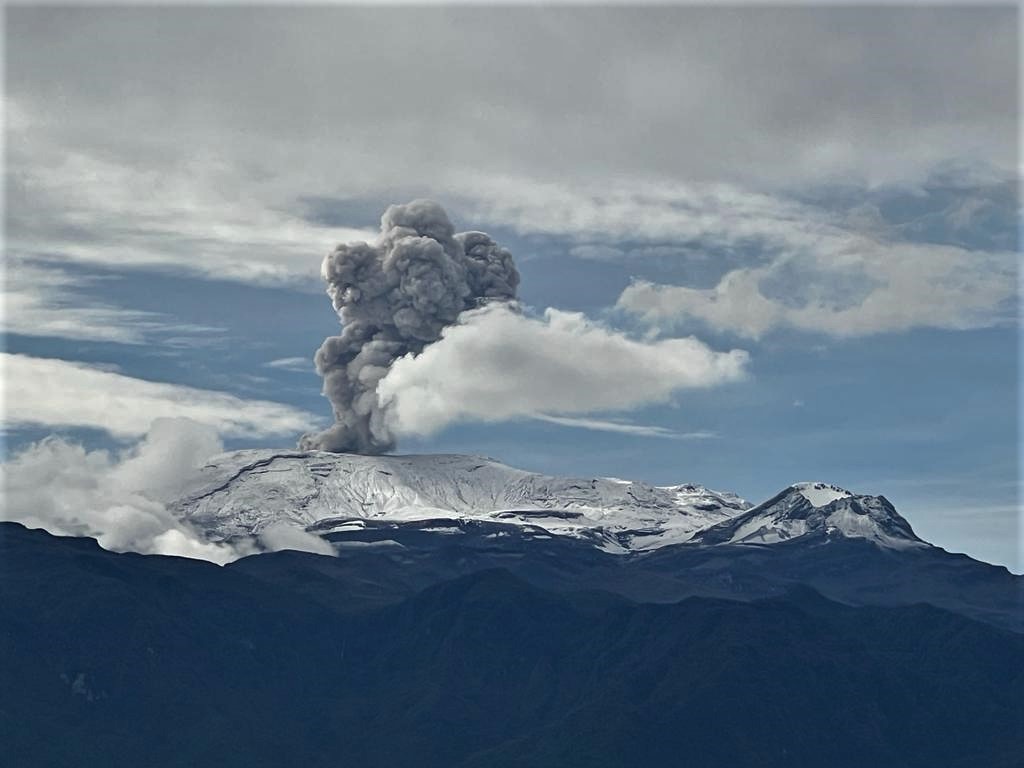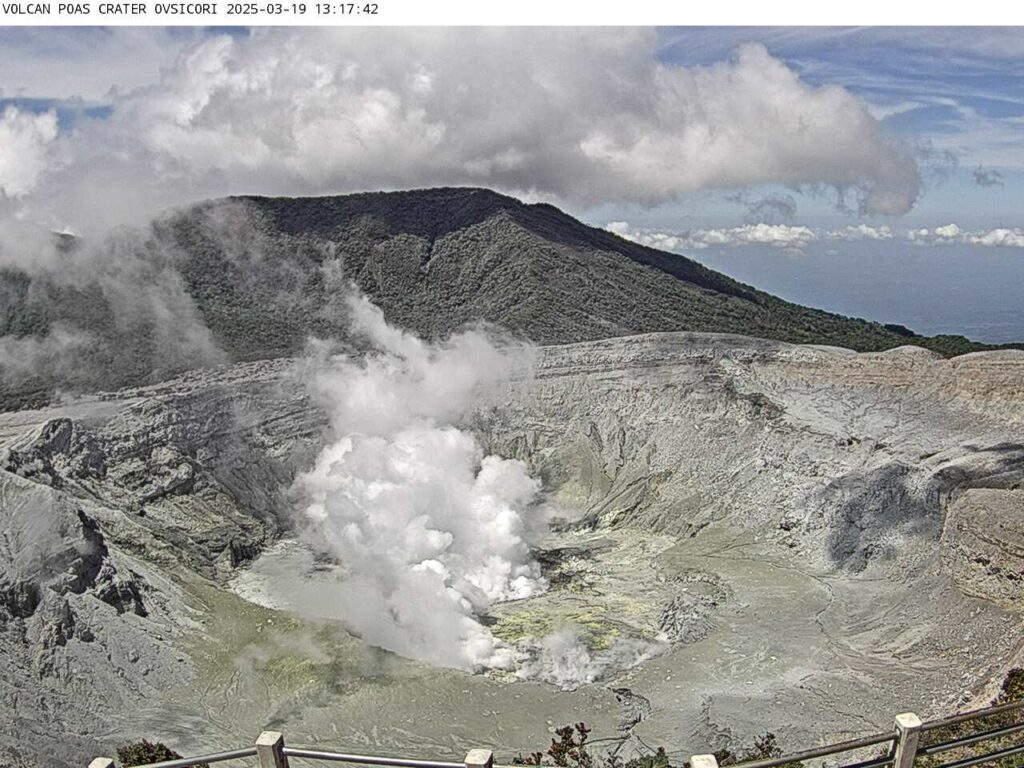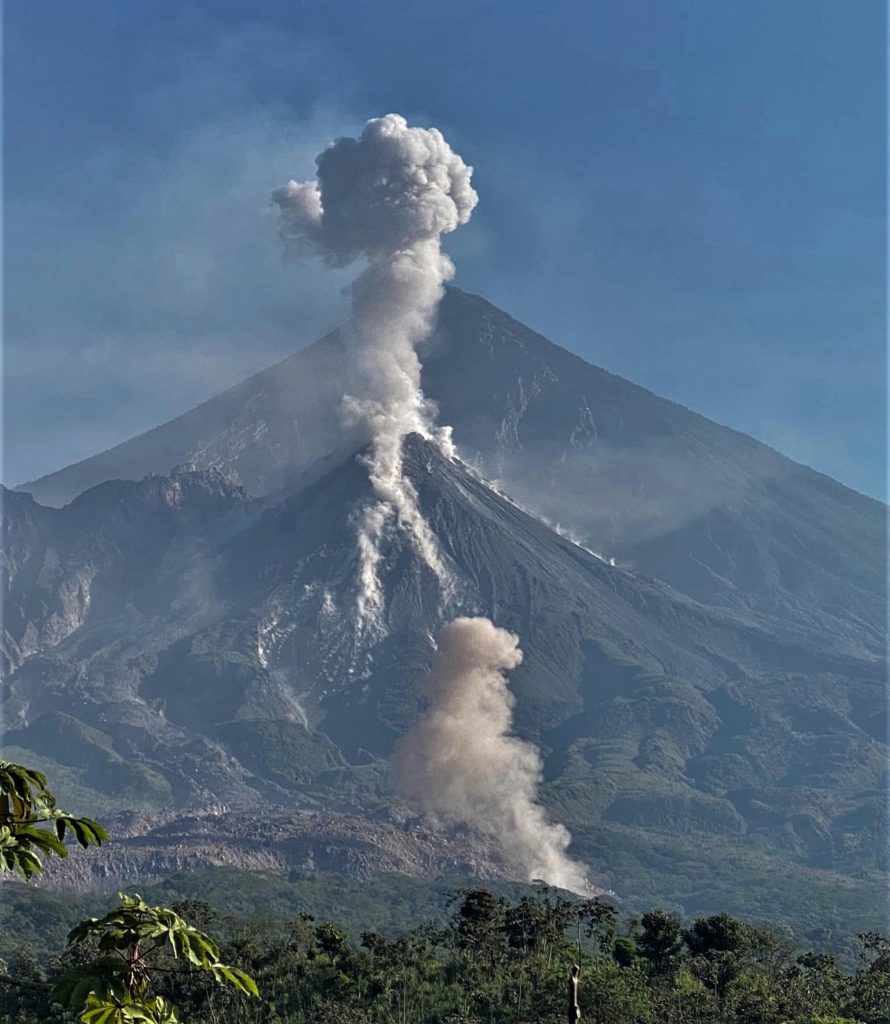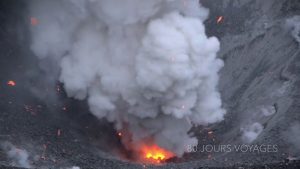March 28 , 2025.
Hawaii , Kilauea :
Thursday, March 27, 2025, 10:22 AM HST (Thursday, March 27, 2025, 20:22 UTC)
19°25’16 » N 155°17’13 » W,
Summit Elevation 4091 ft (1247 m)
Current Volcano Alert Level: ATTENTION
Current Aviation Color Code: ORANGE
Activity Summary:
The summit eruption of Kīlauea, within Halemaʻumaʻu, paused yesterday, March 26, at 7:10 p.m. HST.
Episode 15 of the ongoing Halemaʻumaʻu eruption ended abruptly last night after just over 31 hours, including about 9 hours of high fountaining. Fountaining associated with episode 15 reached heights over 1,000 feet (305 meters) at multiple times during the day yesterday; fountaining remained at or above 600 feet (180 meters) for most afternoon.
Kīlauea’s current eruption in Halemaʻumaʻu crater within Kaluapele (the summit caldera) began on December 23, 2024. There have been 15 episodes of lava fountaining separated by pauses in activity. All eruptive activity remains within Hawai’i Volcanoes National Park. No significant activity has been noted along Kīlauea’s East Rift Zone or Southwest Rift Zone.
Current hazards include volcanic gas emissions and windblown volcanic glass (Pele’s Hair) and tephra that have impacted Hawai’i Volcanoes National Park and nearby communities.
Summit Observations:
Lava flows and fountains stopped erupting from the south vent within Halemaʻumaʻu crater at about 7:10 p.m. HST on March 26. Activity at the north vent had stopped hours earlier, around noon HST. Lava flows from episode 15 covered 80-90% of the Halemaʻumaʻu crater floor. Spots of orange glow can still be seen on the crater floor at night as the erupted lava continues to cool. The south vent continues to degas and glow at night, indicating magma remains at shallow levels in the vent. The north vent was largely infilled with tephra from the south vent, so vent glow was absent in the north vent last night aside from when minor slumping of the vent cone exposed still-hot material.
Tiltmeters at the summit recorded about 9 microradians of deflation at Uēkahuna (UWD) and 7 microradians of deflations at Sand Hill (SDH) during this episode. Initial deflation was very rapid, but slowed around noon HST when north vent activity ceased. The end of the eruption was coincident with a rapid change from deflation to inflation at the summit and a significant decrease in seismic tremor intensity to near zero. In the few hours following the end of the episode, about a dozen small seismic events occurred near the summit; following those events, variably weak seismic tremor has returned. In the past 14 hours, SDH and UWD tiltmeters have each recorded approximately 2 microradians of inflationary tilt since the end of episode 15.
Volcanic gas emissions remain elevated, though wind conditions yesterday and today have prevented acquisition of new emission rate data. Based on measurements made during earlier episodes and pauses, sulfur dioxide (SO2) emission rates were likely around 50,000 t/d during yesterday’s high fountaining and are likely to be approximately 1,000 t/d during the current pause.
Source : HVO
Photos : Volcano Hideaways
Indonesia , Dukono :
An eruption of Mount Dukono occurred on Friday, March 28, 2025, at 07:03 WIT with an observed ash column height of ± 2500 m above the peak (± 3587 m above sea level). The ash column was observed to be white to gray in color with moderate to thick intensity, oriented toward the east. At the time of writing, the eruption was still ongoing.
VOLCANO OBSERVATORY NOTICE FOR AVIATION – VONA
Issued : March 28 , 2025
Volcano : Dukono (268010)
Current Aviation Colour Code : ORANGE
Previous Aviation Colour Code : orange
Source : Dukono Volcano Observatory
Notice Number : 2025DUK046
Volcano Location : N 01 deg 41 min 35 sec E 127 deg 53 min 38 sec
Area : North Maluku, Indonesia
Summit Elevation : 3478 FT (1087 M)
Volcanic Activity Summary :
Eruption with volcanic ash cloud at 22h03 UTC (07h03 local).
Volcanic Cloud Height :
Best estimate of ash-cloud top is around 11478 FT (3587 M) above sea level or 8000 FT (2500 M) above summit. May be higher than what can be observed clearly. Source of height data: ground observer.
Other Volcanic Cloud Information :
Ash cloud moving to east. Volcanic ash is observed to be gray. The intensity of volcanic ash is observed from medium to thick.
Remarks :
Eruption and ash emission is continuing. Eruption recorded on seismogram with maximum amplitude 20 mm. Tremor recorded on seismogram with maximum amplitude 3 mm.
Source et photo : Magma Indonésie.
Colombia , Nevado del Ruiz :
Manizales, March 25, 2025, 6:00 a.m.
Monitoring the activity of the Nevado del Ruiz volcano, the Colombian Geological Survey (SGC), an entity affiliated with the Ministry of Mines and Energy, reports that:
During the week of March 18-24, 2025, the volcano continued to exhibit unstable behavior. Compared to the previous week, the main variations in the monitored parameters were:
– Seismic activity associated with rock fracturing processes within the volcanic edifice increased in the number of recorded earthquakes and in the seismic energy released. Seismic activity was mainly located in the Arenas crater and in the northeast and southeast sectors, at distances less than 6 km from the crater, and to a lesser extent, in the distal south-southwest and northwest sectors of the volcano. The depth of the earthquakes ranged from less than 1 km to 7 km from the volcano’s summit. The highest magnitude of the week was 1.5, corresponding to the earthquake recorded on March 21 at 5:05 a.m., located 11 km northwest of the crater, at a depth of 6 km.
– Although seismicity related to fluid dynamics in volcanic conduits generally maintained similar levels in the number of recorded earthquakes and the seismic energy released, a slight increase was observed in long-duration signals associated with continuous ash emission. The energy levels of the seismic signals ranged mainly from low to moderate, with the exception of a high value recorded on March 22. Using cameras (conventional or thermographic) used to monitor the volcano, it was possible to confirm some continuous and pulsed ash emissions associated with the signals. Changes in the apparent temperature of the emitted material were also observed in relation to these ash emissions.
– The emission of water vapor and gases, mainly sulfur dioxide (SO₂), into the atmosphere through the Arenas crater was variable. Estimated daily values of the SO₂ degassing flux showed a slight increase compared to the previous week. Satellite monitoring, which is being carried out to complement the assessment of this parameter, continues to show significant SO₂ releases.
– The vertical height of the gas column remained mainly below 600 m measured above the volcano’s summit, with a maximum of 1200 m. In dispersion, the column reached a maximum height of 2000 m during the emission of gas and ash on March 22 at 6:53 a.m. The dispersion direction showed a predominant trend toward the west-northwest and northwest of the volcano, generating ashfall in the municipalities of Villamaría and Manizales, in the department of Caldas, on the morning of March 22.
– By monitoring thermal anomalies at the floor of the Arenas crater and using satellite monitoring platforms, several anomaly reports with low to moderate energy levels were obtained.
Source et photo : SGC
Costa Rica , Poas / Rincon de la Vieja :
Date: March 27, 2025, updated at: 10:13:00 AM.
Poas Volcano
Latitude: 10.2
Longitude: -84.233
Altitude: 2,687 meters
Observed Activity:
The eruptive activity that began on March 23 continues with phreatic eruptions and ash emissions. The SO2 gas flux emitted yesterday was approximately 600 tons per day. Geodetic monitoring detects moderate vertical uplift affecting the crater area, and an extension of the volcanic edifice is also observed.
Eruptive activity intensified significantly on March 24 and continues, with frequent, weak to moderate explosions.
An increase in ash content was observed compared to the previous day. The low visibility over the plume yesterday allowed for an increase in ash content compared to the previous day. Due to cloud cover, no observations were possible at the time of writing.
Environmental Conditions:
Cloud cover hinders visibility at the summit. The wind is blowing southwest (4 m/s).
Activity Level: Caution (3)
Rincon de la Vieja Volcano
Latitude: 10.83
Longitude: -85.324
Altitude: 1,916 meters
Observed Activity:
No eruption has been recorded and seismic activity is low. Geodetic measurements show stability at the base and summit of the volcanic edifice. Yesterday, the SO2 gas flux was close to 160 tons per day.
Environmental Conditions:
Cloudy weather at the summit, with southwest winds (6 m/s).
Activity Level: Warning (2)
Source et photo : Ovsicori.
Guatemala , Santiaguito :
Weather: Clear.
Wind: Northeast.
Precipitation: 0.0 mm.
Activity:
Activity is reported at the Caliente Dome of the Santa María-Santiaguito volcanic complex, characterized by white outgassing at an altitude of 500 meters above the crater. Weak to moderate explosions are generated, sending columns of gas and ash to heights of 800 to 900 meters above the dome, which are carried by the wind toward the southwest. At night, incandescence has been observed in the crater.
The Santiaguito Volcano Observatory (OVSAN) reports the collapse and descent of volcanic material toward the southern and southwest flanks of the dome. Activity remains high, so it is possible that, due to explosions or the effects of gravity, some of the accumulated material could collapse and generate pyroclastic flows over long distances toward the southwest, south, and southeast. Therefore, it is advisable to follow the recommendations of special bulletin BESAN-002-2025.
Source : Insivumeh
Photo : Armando Pineda

